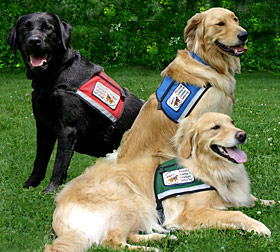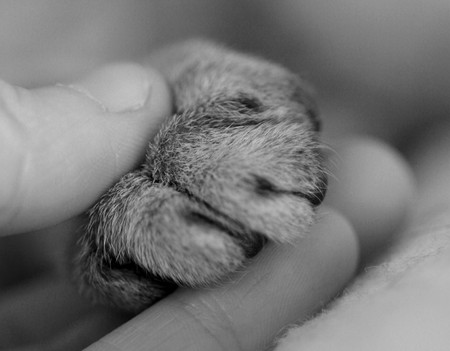It’s National Dog Bite Prevention Week
It’s National Dog Bite Prevention Week
 This week, May 20-26, is National Dog Bite Prevention week, an event hosted by the American Veterinary Medical Association (AVMA) to help educate the public about the nearly 5 million dog bites that occur every year and how they can be prevented.
This week, May 20-26, is National Dog Bite Prevention week, an event hosted by the American Veterinary Medical Association (AVMA) to help educate the public about the nearly 5 million dog bites that occur every year and how they can be prevented.
According to the AVMA 4.7 million people in the US are bitten by dogs each year, and over 800,000 Americans seek medical attention for those bites. Of those, about half are children, with the most at-risk age group being 5-9. Most of these bites occur during every day activities while these children are interacting with familiar dogs. Senior citizens are the second most commonly affected group.
The thing about dog bites is that many, if not most, are preventable. The AVMA has created a great public health bulletin with great tips and resources for people.
Because children are most at risk for bites you should never (ever, ever, ever!) leave a small child alone with a dog. Even if your dog is the world’s biggest softy, it’s never a good idea to leave him unattended with a child. Most dog bites happen while dogs and children are left alone together, even if it’s only for a few minutes.
It is always important to remember that any dog can bite; even the most friendly and well-trained – especially if they are injured or fearful. Proper training and socialization of puppies and dogs is crucial to avoiding dog bites.
According to veterinary behaviorist Sophia Yin DVM MS, “The consensus among animal behavior professionals is that the major cause of dog bites to humans is related to failure of owners and dog bite victims to recognize when dogs are fearful and know how to approach and greet dogs appropriately.”
When approaching a dog, children (and adults) should use the acronym “WAIT” to remind themselves of proper doggie etiquette:
- W – Wait to see if the dog looks friendly. If the dog looks afraid or angry, STOP and walk away slowly.
- A – Ask the owner for permission to pet the dog. If the owner says no or there is no owner present, STOP and walk away slowly.
- I – Invite the dog to come to you to sniff you. Put your hand to your side with your fingers curled in. Stand slightly sideways and dip your head down so you are not looking directly at the dog. If the dog does not come over to sniff you, STOP and do not touch him.
- T – Touch the dog gently, petting him along his back while staying away from his head and tail.
It’s also extremely important to learn to recognize a dog’s body language. Dogs who are growling or baring their teeth are obvious dangers, but dogs who are nervous or frightened are just as likely to bite, if not more. Here are some great slides from the ASPCA to help you learn how to interpret a dog’s body language to better be able to identify dog’s who may pose a biting risk.
The goal is not to be afraid of meeting new dogs, but of being respectful of the dog’s personal space. If we all follow these tips maybe we can all stay a little safer around our furry friends.
CareCredit: A Payment Alternative
 Sometimes life’s unexpected expenses add up. When your pet is facing major veterinary needs, it can be difficult enough to make decisions, let alone weigh cost into the mix. CareCredit is an alternative payment option to traditional credit cards or loans that can help you afford the care you want for your pet, when you want it. While CareCredit works like a credit card, it is different in several ways:
Sometimes life’s unexpected expenses add up. When your pet is facing major veterinary needs, it can be difficult enough to make decisions, let alone weigh cost into the mix. CareCredit is an alternative payment option to traditional credit cards or loans that can help you afford the care you want for your pet, when you want it. While CareCredit works like a credit card, it is different in several ways:
- CareCredit can only be used at approved healthcare providers, including many veterinarians. This helps you to use your credit wisely and pay cash for other things.
- Every time you use your CareCredit card, you are eligible for special financing plans. This can include no interest if paid in full within the 6, 12, 18, or 24 month period determined by the amount of the charge. While minimum monthly payments are required, you may pay off your balance before the end of the promotional period.
- Once approved, you can start using CareCredit immediately. You can apply conveniently over the phone or online before taking your pet in to the vet and use your credit line that day.
CareCredit is a great way to pay for the medical care your pet needs now while spreading the cost out over a longer time period. For more information, or to apply online, visit www.carecredit.com.
Returning the Favor
 Service animals are amazing creatures. They selflessly and lovingly perform all sorts of tasks for their human wards. Every once in awhile it is nice for us to be able to return the favor to them. That is why Dr. Gearhart, Oakland Veterinary Referral Service’s veterinary ophthalmologist, is participating in ACVO/Merial’s National Service Dog Eye Exams during the month of May.
Service animals are amazing creatures. They selflessly and lovingly perform all sorts of tasks for their human wards. Every once in awhile it is nice for us to be able to return the favor to them. That is why Dr. Gearhart, Oakland Veterinary Referral Service’s veterinary ophthalmologist, is participating in ACVO/Merial’s National Service Dog Eye Exams during the month of May.
During this campaign, boarded veterinary ophthalmologists provide free ocular screening examinations to qualified service animals. During this screening, problems such as redness, squinting, cloudy corneas, retinal disease, cataracts, and other serious diseases will be able to be identified. By providing this service, they hope to identify and prevent any problems that may affect the animal’s vision. Detecting problems early is essential to these dogs’ futures.
If you would like more information regarding this program or would like to find out if an animal you know meets the qualifications, please visit our ophthalmology page and click on “Free Eye Exams for Active Service Dogs.”
All about heartworm disease… How much do you know?
 So, what exactly is heartworm disease? Heartworm disease refers to clinical symptoms that result from a parasite injected into the bloodstream by mosquitoes.
So, what exactly is heartworm disease? Heartworm disease refers to clinical symptoms that result from a parasite injected into the bloodstream by mosquitoes.
Heartworms go through several cycles of maturation:
- Larvae are injected into the dog’s blood stream by a mosquito bite. These larvae travel to arteries within the lungs and become sexually productive adult worms.
- Adult worms produce “heartworm babies” which are ingested by mosquitoes after biting an infected dog.
- These babies go through another growth phase within the mosquito and the larvae are then injected back into another dog via a bite from the mosquito.
- Lather, rinse, repeat…
Clinical signs that are associated with heartworm disease are due to inflammation within the lungs. An intense inflammatory reaction causes lung disease and respiratory symptoms (coughing, shortness of breath). In advanced stages of the disease, the patient may become weak and have signs of respiratory distress.
Cats are not a part of the heartworm life cycle, but they can become infected. A cat may become ill after being infected with only one heartworm. A small number of worms may not cause symptoms in a dog, but the dog may serve as a reservoir of infection for other dogs.
Prevention (Human and Animal):
Owners can help decrease exposure to mosquitoes and limit their reproduction by removing any standing water on their property. Whenever possible, cover any open sources of water. Fish may help reduce the mosquito population around ponds.
Dark clothing attracts mosquitoes, so people should wear lighter colors. Mosquitoes are most active at night, so both you and your pets should avoid excessive outdoor activity after sundown. Whenever you are outdoors, wear mosquito repellent and check with your veterinarian for a pet-safe mosquito repellent for your dog or cat.
Other ways to minimize exposure to mosquitoes include using screens in your windows and doors and inspecting them to ensure there are no holes large enough for a mosquito to fit through. Avoid having your doors open any longer than necessary at night.
The most important preventative measure for your pet is a monthly oral preventative medication such as Hartguard. Ask your veterinarian which brand they recommend and be sure to keep your pet protected.
Treatment:
Medical management of heartworm infection is aimed at destroying the worms and treating any secondary complications that result from the infection. Some patients require medications to relieve inflammation within the lungs. To “kill” the adult worm, there is a specific agent that is injected. The third phase of therapy is to reduce the number of “heartworm babies” in the bloodstream. The medication used to eradicate adult worms cannot be used in cats. Heartworms have a shorter life span in cats, so the clinical signs are generally treated medically until the worm dies on its own. In very advanced cases in both dogs and cats, surgical extraction of the adult worms from the heart may be required.
If your pet is not yet on a heartworm preventative, be sure to call your veterinarian as soon as possible. Heartworm is much easier to prevent than it is to treat. If you’re interested in learning more about veterinary cardiology, you can visit our cardiology page.
When your pet is hospitalized…
 Sometimes hospitalizing a pet is unavoidable. We know that leaving your pet with us can be very stressful, especially when that pet is very ill. We take caring for your animal very seriously and want to ensure the best possible experience. Use the following tips to help decrease the amount of stress involved in the hospitalization of your pet:
Sometimes hospitalizing a pet is unavoidable. We know that leaving your pet with us can be very stressful, especially when that pet is very ill. We take caring for your animal very seriously and want to ensure the best possible experience. Use the following tips to help decrease the amount of stress involved in the hospitalization of your pet:
- Pick a primary contact. Many times when a pet is hospitalized, serious discussions must be had and decisions made. It is helpful if one person is the primary contact for the doctor. This helps to minimize confusion and keeps communication clear. It is also important that this person be readily available by phone in case of emergency.
- Feel free to call. While you will be updated by your pet’s doctor frequently, we realize you are probably worried. Know that we will always update you immediately regarding major changes in your pet’s health. You may also feel free to call and “check-in” at any time. If you do so, however, please realize that the doctor may be busy caring for your or other pets and that the staff may only be able to give you limited information.
- Observe visiting hours. Because of the nature of a hospital, heavy visitor traffic can disrupt the care of our patients. We encourage you to visit your pet between 6 p.m. and 8:30 p.m. We also ask that you limit visits to 15 minutes. If you are unable to visit during visiting hours, please talk to your pet’s doctor regarding other arrangements.
- Schedule your discharge. When your pet is being released from the hospital, please schedule a time during normal hours to pick him/her up. This way the doctor can set aside time to talk with you and answer any further questions. After hours discharge is also available, although your pet’s doctor may not be. In this instance, another staff member will release your pet.
If your pet is scheduled to be hospitalized with us, please contact us with any questions or concerns that you may have.
Doggie Blood Donors: Volunteering Your Dog to be a Buddy for Life
 Chances are you have given blood
Chances are you have given blood  at some point in your life- it’s a great feeling! Did you know that your pup can offer the same favor to his canine comrades? OVRS runs its very own canine blood bank called Buddies for Life which collects and stores blood products that can be used to treat a variety of doggie problems including blood loss, immune mediated diseases, genetic disorders, and more!
at some point in your life- it’s a great feeling! Did you know that your pup can offer the same favor to his canine comrades? OVRS runs its very own canine blood bank called Buddies for Life which collects and stores blood products that can be used to treat a variety of doggie problems including blood loss, immune mediated diseases, genetic disorders, and more!
Volunteers to donate blood are always needed. The Buddies for Life Blood Bank will be hosting a blood drive on June 2nd. A donation of your time and your dog’s blood can help save many lives, through the over 400 transfusions OVRS performs every year.
Because of the physical demands required when donating blood, donors should be in good general health, over 50 pounds, and between 1 and 7 years of age. Dogs that have a generally outgoing and friendly disposition are best suited to the rigors of donation.
If you think that your dog might have what it takes to be a donor, or if you would like more information regarding our blood bank, please download the donation form or contact us at bloodbank@ovrs.com.


